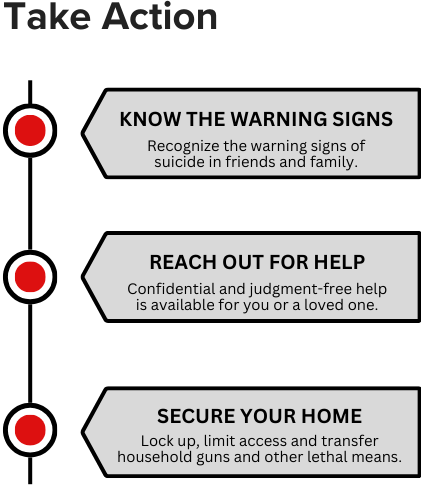Help is Just a Conversation Away
- National Suicide Prevention Lifeline:
Call 988 or 1-800-273-TALK (8255) Veterans Press 1 - Crisis Text Line:
Text HOME to 741-741 - Maryland 24/7 Helpline:
Call 211, select option 1 or Text your zip code to 898-211 - County Warmline:
410-768-5522 24 hours a day, 7 days a week
Gun suicides are a leading cause of death and a public health concern in Anne Arundel County
There are 130 suicides per day in the United States on average. In Anne Arundel County, suicides are on the rise with an average of 79 deaths and 805 attempts each year. As of 2021, suicide is the ninth leading cause of death in the county at a rate of 12 deaths per 100,000 residents. Firearms are the most common method of suicide death and account for an average of 30 suicides each year. Similar to national trends, the majority of county gun-related suicides (78%) are among middle-aged white males.
Means Matter
In the United States, guns are a common and highly lethal method for suicide. In Anne Arundel County, guns are the most common means in suicide deaths and the fifth most common means in suicide attempts. Suicides account for nearly two-thirds (65%) of all gun fatalities compared to one-third of homicides, a rate higher than that for Maryland and the United States. Changing the means can save lives because it reduces the deadliness of suicide attempts. The Means Matter Campaign explains the importance of putting time and distance between a suicidal person and a gun.
Reduce Access to Lethal Means
In most instances, suicide is a short-term decision made when someone is in crisis. The time between a person's decision to take their life and the suicide attempt is often less than an hour. This is why ready access to a gun is so dangerous. Simply having access to a gun triples a person's risk of death by suicide. Temporarily removing a gun at the right moment can help someone at risk for suicide. Of individuals who attempt suicide and survive, nine out of 10 will not go on to die by suicide at a later date.
Suicides Are Preventable
There are several simple steps that you as an individual, a family member and a friend can take right now to protect yourself and those you care about from suicide. Use the resources on this page to learn more about the warning signs of suicide, where to go for help, and what you can do to make your home safer.

Safe Storage Options
Securely store household guns to prevent children, grandchildren, other family members, or friends from gaining access.
Lock Up: Use a gun lock or safe to securely store guns. Store ammunition separately.
Limit Access: Make sure only the gun owner has access to keys or combinations to locked guns.
Transfer: Consider temporarily storing your guns with a trusted individual outside of your home.
Learn more about gun locks, boxes or safe options that match your needs or lifestyle while reducing the risk of injury or death.
Free gun safety kits are available at the following sites:
- Anne Arundel County Police Department
- Anne Arundel County Sheriff's Office
- Annapolis Police Department
Temporary Offsite Storage Options
There are plenty of reasons why gun owners may want to temporarily store their firearms outside of their home. In Maryland, you can temporarily store your guns with a firearm dealer, police department, friend or family member. As an adult friend or relative, you can also help a loved one with temporary safe storage.
Learn more about safe storage site locations and options in Anne Arundel County from Marylanders to Prevention Gun Violence.
In this short video clip, the Utah Suicide Prevention Coalition shares the importance of temporary storage:
Extreme Risk Protective Orders (ERPOs)
An ERPO, referred to as "red flag laws," is a court-issued order that temporarily prohibits a person from purchasing and possessing guns and ammunition. When someone is behaving dangerously and at risk of harming themselves or others, an ERPO may be used to temporarily restrict their access to guns.
For more information about ERPOs, visit these resources:
Military members and veterans are at an increased risk for suicide with a suicide rate 57% higher than non-Veteran adults. In 2020, suicide was the 13th leading cause of death in Veterans and the second leading cause in Veterans under age 45. In Maryland, the veteran suicide rate is 24.5 per 100,000 residents, slightly lower than the national rate of 33.9 per 100,000 residents. Veterans make up around 7% of the adult population in the state and 11% in Anne Arundel County.
The Veteran Crisis Line provides free, confidential support for service members, veterans and their families that are seeking help for themselves or someone else.
Stop Soldier Suicide connects service members and veterans with a wellness coordinator who provides personalized support.
The American Foundation for Suicide Prevention created the following lists of mental health and suicide prevention resources for communities of color and the LGBTQ+ community.
- Black community
- Latinx community
- LGBTQ+ community
- Native and Indigenous community
The Trevor Project provides crisis support services for LGBTQ youth in need.
Clinicians can support individuals at-risk of suicide by working with them to fill out a safety plan. The Stanley-Brown approach to safety planning intervention offers a step-by-step process for assessing suicide risk and going through a quick collaborative process to draft a safety plan with a client.
Question. Persuade. Refer.
The QPR Institute offers several skill-based courses to prevent suicide and save lives. The courses are intended to train anyone to recognize the signs of someone in crisis, intervene and get them help. Their trainings range from individual 60-minute courses to full-day professional certifications. Learn more and get certified today by visiting the training site.
Counseling on Access to Lethal Means (CALM)
This free course is intended for individuals who work with people at risk for suicide, including mental health professionals, health care providers, and social service professionals. Enrollment in the course is free and should take no more than a couple hours. Learn more and get certified today by visiting the training site.
You can learn more by visiting the Maryland Department of Health's Suicide Prevention in Primary Care Toolkit.
Data Sources:
- Suicide rates: Five-year (2013-2018) yearly suicide and gun fatality averages from the Vital Statistics Administration (VSA) and the Anne Arundel County Department of Health's Report of Community Health Indicators (May 2019).
- Suicide means data: CDC's National Center for Injury Prevention and Control. Web-based Injury Statistics Query and Reporting System (WISQARS)
- Suicide timing data: Simon, O. R., et al. (2001). Characteristics of impulsive suicide attempts and attempters. Suicide and Life-Threatening Behavior. https://doi.org/10.1521/suli.32.1.5.49.24212
- Suicide means risk data: Anglemyer A., Horvath T., & Rutherford G. (2014). The Accessibility of Firearms and Risk for Suicide and Homicide Victimization Among Household Members. Annals of Internal Medicine. https://doi.org/10.7326/M13-1301
- Maryland Suicide Data Sheet, 2021
- County veteran data: Maryland Department of Veterans Affairs 2017 Annual Report
- Maryland Department of Health, Vital Statistics Administration, 2021 Annual Report and Jurisdictional Deaths Report for Anne Arundel County.
- 2022 National Veteran Suicide Prevention Annual Report
Toolkit Resource Sources
- Suicide Prevention Postcard: Anne Arundel County Department of Health's Gun Violence Intervention Team
- Safe Storage Options: Project ChildSafe
- ERPO Postcard: Maryland Suicide Prevention Program
- Minority community resource lists: American Foundation for Suicide Prevention
Supporting Documents
- Anne Arundel County Conflict Resolution And Resources
- Black Community Suicide Prevention Resources
- ERPO Postcard - English
- ERPO Postcard - Español
- Gun Suicide Prevention Postcard
- Latin X Community Suicide Prevention Resources
- LGBTQ Community Suicide Prevention Resources
- MD Licensed Firearm Dealers Association Brochure
- MDH Suicide Prevention Toolkit 2021
- MDH Youth Gun Safety Toolkit
- Native American Community Suicide Prevention Resources
- NSSF Firearm Suicide Prevention Brochure
- Safe Home Environment Veteran's Affairs
- Safe Storage Options
- Señales De Advertencia Sobre El Suicidio
- Support After Mass Violence
"Firearms should always be stored safely and locked separately from ammunition. That's one of the most important things you can do [to prevent gun violence]."
- Paul Nestadt, M.D., Johns Hopkins University
Stay Informed
Get notified on upcoming engagements and the latest project related news.

